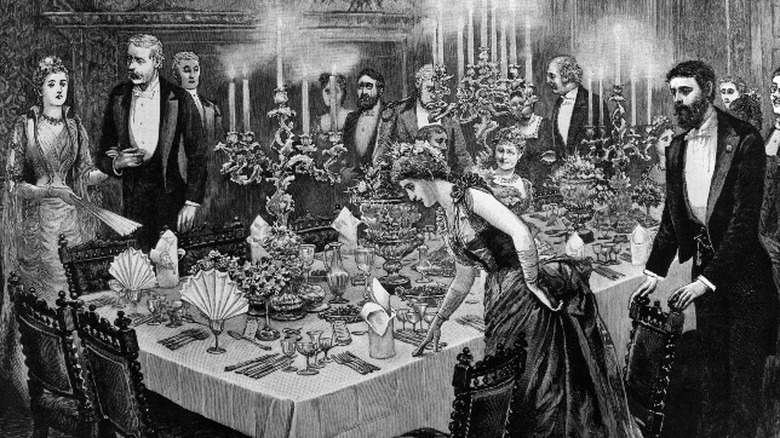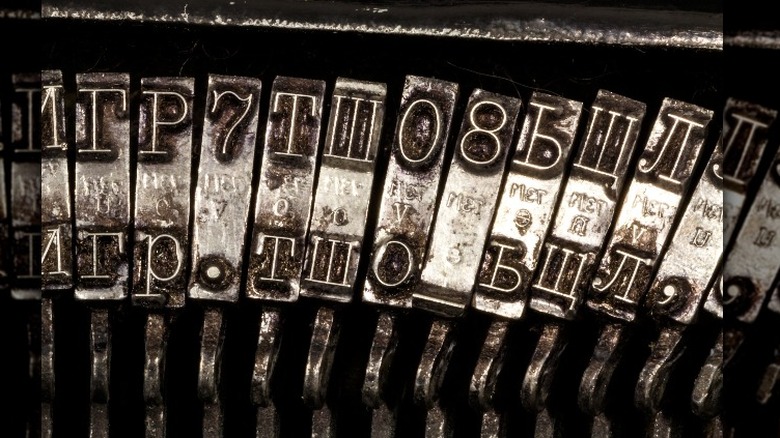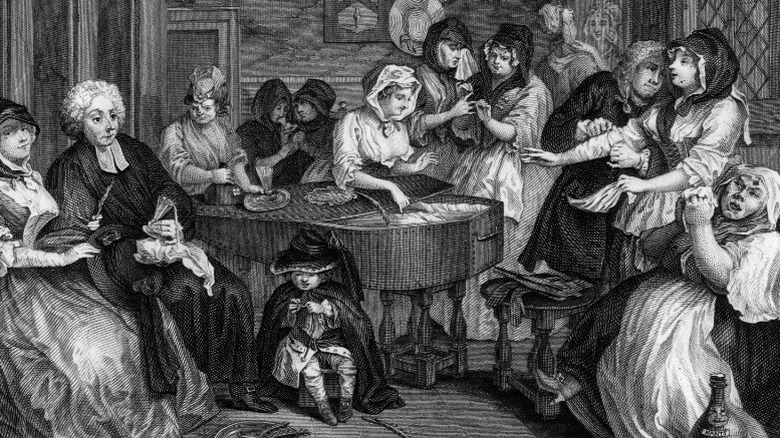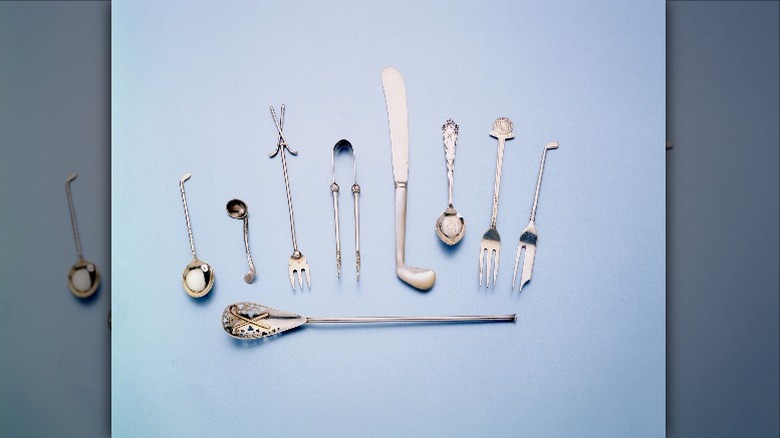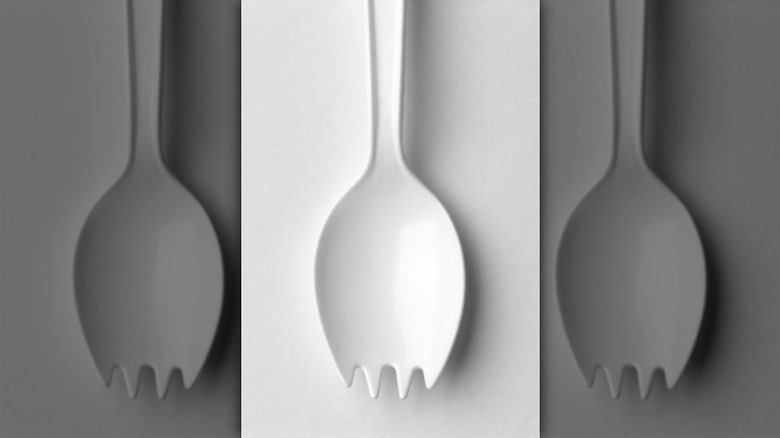The Wild Story Of The Man Who Invented The Spork
As the inventor of the self-opening coffin, the piano typewriter, and the postage-cancelling device, Samuel Ward Francis may not have anticipated that his most enduring brainchild would be the spork. Regardless, his 1874 design for a fork-spoon hybrid utensil contraption (dubbed "Improvement in Combined Knives, Forks, and Spoons" via Google Patents) would become the blueprint for the mass-produced combination cutlery that can now be found in every prison cafeteria, school lunchroom, and military mess hall in the 21st century.
Samuel Ward Francis was, by all accounts, an eccentric entrepreneur, an enthusiastic advocate for others, and a bona fide Renaissance man. Francis was a romance novelist, a medical doctor, an avid thinker, a philanthropist, and a well-respected community member in his home state of New York (per Newport Daily News). While Francis' design for a fork-spoon hybrid utensil is his most-lauded contribution, that may be the least interesting thing about him. Throughout his life Francis demonstrated good-natured, zealous conviction and a quasi-outlandish business acumen.
The Early Life of Samuel Ward Francis
Samuel Ward Francis was born in 1835 to a well-to-do family in New York state's Old Money aristocracy. His father, Dr. John Wakefield Francis, was a prominent New York medical doctor who bore four sons: one died in infancy, one died while completing his studies, and the other two followed in their father in his trade. Samuel Ward Francis was the youngest of the bunch. He earned his M.D. from the University Medical College of New York to appease his father (per Newport Daily News), but the youngest Francis son was more enthralled by patents than prescriptions.
Francis was well-traveled, academically adept, and by all accounts a stellar student with a keen mind. He graduated from Columbia College in the late 1850s with a formidable resume of academic and professional achievements, but neither his class presidency nor his awards in mathematics would prove as enduring as his invention of the spork. He was a beloved physician and distinguished philanthropist evidently much-cherished by his community until his death in Newport at the age of 50. As Mental Floss noted, his eccentricity was matched only by his kindness.
The Piano Typewriter (The Francis Printing Machine)
From an early age, Francis reputedly dreamed up an extensive repertoire of original inventions — according to his obituary in Newport Daily News, his family kept a full roster with over 100 of his contrivances. Over the course of his life, 17 of Francis' inventions were officially patented. Among the first was an 1857 device he dubbed the "Francis Printing Machine," a type of functional typewriter with a lightweight wooden frame and four piano keys used for typing. (A patent model is cataloged in the Smithsonian's National Museum of American History collections.)
Francis' 1857 piano typewriter demonstrated remarkable prescience with its use of a type hammer, which served a function similar to the ribbon-realignment type guide mechanism, as Vox explains, that would later become a feature of nearly every mainstream typewriter device. (Francis' obituary in Newport Daily News recounts this fact with great bitterness.)
The self-opening coffin and alarm telegraph
Samuel Ward Francis' other inventions included a matchbox that ignites from the inside (via Google Patents), a postage-cancelling device (also via Google Patents), and a cane with a hidden compartment for bus fare (again, at Google Patents), according to Vox.
In 1868, he invented the self-opening coffin and alarm telegraph. In "Curious Facts Concerning Man and Nature," he described his invention: if a person has the misfortune to be buried alive and awakes from a trance inside a coffin, the self-opening coffin would be designed so that any movement of their hands would trigger springs opening the coffin. Simultaneously, the self-opening coffin, when activated, would trigger an alarm. After the coffin lid has opened, Francis explained, "the telegraph wire has run a bell in the keeper's lodge, and called his attention to the alarming fact that 'Vault No. 67 has come to life — send assistance.' This invention is important to the public, and I sincerely hope that it may be adopted by some large corporation," he wrote.
Romance Novels & Spork Wars
Francis also wrote several books, including a work about the history of water and its properties (1861's "Water: Its History, Characteristics, Hygienic, and Therapeutic Uses"). His book "Curious Facts Concerning Man and Nature" (per National Library of Medicine Digital Collections) contained an array of unusual theories about the world, including some about the God-given purpose of mosquitoes, and the significance of vegetable shapes' resemblance to human organs. Francis also tried his hand at two romance novels: "Inside Out: A Curious Book" and "Life and Death" (per Newport Daily News).
In 1874, he patented the spork. Francis was not the first (nor the last) to envision more efficacious eatery. According to The New York Times Magazine, various hybrid utensils like the terrapin fork predate Francis' 1874 spork design. An array of competing spork-like devices would earn patents in the following decades. Other contenders in the Spork Wars included Harry L. McCoy's "Cutting-spoon" design (1908); Frank Emmenegger's perforated-edge "Spoon" (1912); and even William McArthur's "Splayd" combination utensil, an Australian-invented triple threat branded in the 1940s (per Ateriet).
Yet it was Francis' 1874 design — "Improvement in combined knives, forks, and spoons," per Google Patents– that would become the blueprint for the spork as we know it today. The concave bowl of a spoon with the parallel teeth of a fork (and a flat knifelike edge jutting from the spoon-bowl's side) is recognizable to any modern consumer.
A legacy in every lunchroom
"The object of this invention is to combine in a convenient manner, in one implement, a knife, fork, and spoon," Francis explained in the patent description (via Google Patents). "... It will, of course, be understood that the pattern or special configuration of the article can varied, according to taste or the demands of the market ... struck up in one piece from sheet metal, or may be made in any other suitable way."
The term "combination fork and spoon" isn't very marketable, however. In the early 1950s, Hyde W. Ballard was the first to copyright the clever neologism "spork" (per 1952 Official Gazette of the U.S. Patent Office, via Internet Archive), although the term first appeared in a Century Dictionary supplement in 1909. The Van Brode Milling Company patented plastic hybrid utensils with the name "spork" in the 1970s (via National Geographic). A few decades later, plastic sporks began to flood cafeterias en masse, and the moniker earned its place in the vernacular (per Google Books Ngram Viewer). A spork named Forky (voiced by Tony Hale, per Yahoo!) was a pivotal character in "Toy Story 4."
By the late 20th century, the spork had earned ubiquity. The spork secured its place within the hodgepodge menagerie of mass-produced consumer items littering the landscape of the 21st century — of all his inventions, it was the spork that would survive the century-and-a-half after his death. Samuel Ward Francis' legacy survives with it.

